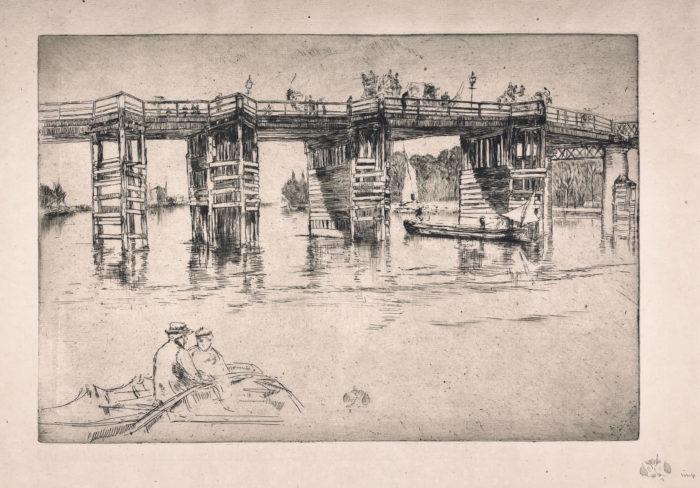Old Putney Bridge
Tuesday, January 17th, 2023
James Whistler (1834-1903), Old Putney Bridge, 1879, etching and drypoint, signed in pencil with a large, elaborate shaded butterfly, lower right and inscribed imp (also signed with the butterfly in the plate), printed in dark-brown/black ink on laid paper, watermark ProPatria, an impression in Glasgow’s seventh (final) state, published by The Fine Art Society, probably printed in 1881, 8x 11 3/4 inches, sheet 12 1/8 x 16 1/8 inches. Reference: Kennedy 178; Glasgow 185.
Provenance: Kraushaar Gallery, New York
A fine impression, with wide margins.
The Fine Art Societys relationship with Whistler began with the new etchings of the Thames he made in 1879, following a visit from Ernest Brown who had joined the staff of the gallery. The plate is on a large scale and shows the change in the artists approach to the Thames since the etchings he had made in Wapping and the docks in the summer of 1859. The central motif is the old bridge, by this stage somewhat dilapidated. It was shortly to be demolished and replaced by the new bridge of Cornish granite which was opened in 1886. Whistlers instinct for preservation and his interest in Japanese art combine in this work, which successfully incorporates both the Western tradition and the influence of Japan. This impression was probably printed in 1881 or earlier and is printed on a full sheet signed with a large butterfly with veined wings. The printing of the edition was not completed until 1889. The Fine Art Society received 21 impressions in 1885, twelve in 1887 and a further six in 1887. The cancelled plate was delivered to The Fine Art Society in 1889, after Whistler had taken a print showing the cancellation, but the plate’s current whereabouts are unknown. The work was first exhibited at the Royal Academy of Arts in 1879.